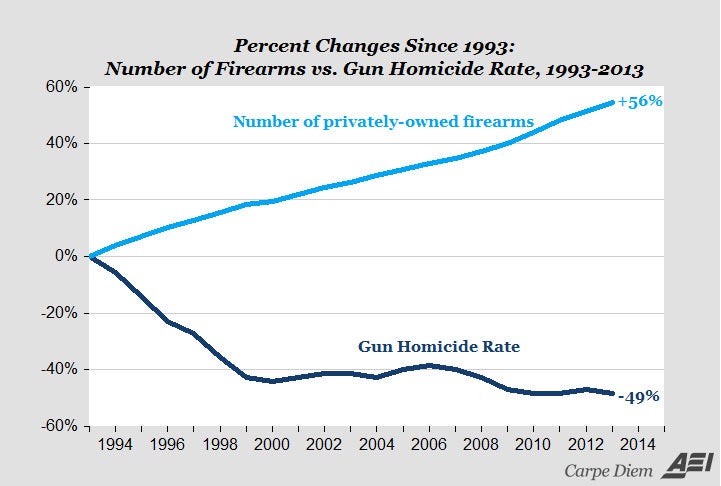Source (permission to re-post given in the article): http://www.alloutdoor.com/2015/12/11/1993-to-2013-more-guns-less-gun-crime/

This falls in the category of things we already knew–most of us, anyhow–but which really need to be presented and explained to all those who shout for even more restrictive gun laws than the already-failed ones we have.
American Enterprise Institute created this image to illustrate that, while the number of guns in the USA increased radically over a twenty-year period, the number of gun homicides fell dramatically, as explained in a post on their site.
The chart above was created after the one below; as explained in the post, a reader found the earlier one misleading due to the intersection of the lines, which appears to indicate degradation before improvement.

From the article:
According to data retrieved from the Centers for Disease Control, there were 7 firearm-related homicides for every 100,000 Americans in 1993 (see light blue line in chart). By 2013 (most-recent year available), the gun homicide rate had fallen by nearly 50% to only 3.6 homicides per 100,000 population.
~~~~~~~~~~~~~~~~
Based on data from a 2012 Congressional Research Service (CRS) report (and additional data from another Wonkblog article “There are now more guns than people in the United States“), the number of privately owned firearms in US increased from about 185 million in 1993 to 357 million in 2013. Adjusted for the US population, the number of guns per American increased from 0.93 per person in 1993 to 1.45 in 2013, which is a 56% increase in the number of guns per person that occurred during the same period when gun violence decreased by 49%…
~~~~~~~~~~~~~~~~
Bottom Line: Even if you’re not convinced that increased gun ownership reduces violent crime and gun homicides, you should be totally convinced of this indisputable fact: Gun violence has been decreasing significantly over time, not increasing as you’ll frequently hear from anti-gun politicians and progressives. The gun-related homicide rate of 3.6 deaths per 100,000 population in each of the years 2010, 2011 and 2013 makes those recent years the safest in at last 20 years, and possibly the safest in modern US history…
Feel free to share this with your friends, especially those who keep calling for government bans on our only effective means of self-defense.

This falls in the category of things we already knew–most of us, anyhow–but which really need to be presented and explained to all those who shout for even more restrictive gun laws than the already-failed ones we have.
American Enterprise Institute created this image to illustrate that, while the number of guns in the USA increased radically over a twenty-year period, the number of gun homicides fell dramatically, as explained in a post on their site.
The chart above was created after the one below; as explained in the post, a reader found the earlier one misleading due to the intersection of the lines, which appears to indicate degradation before improvement.

From the article:
According to data retrieved from the Centers for Disease Control, there were 7 firearm-related homicides for every 100,000 Americans in 1993 (see light blue line in chart). By 2013 (most-recent year available), the gun homicide rate had fallen by nearly 50% to only 3.6 homicides per 100,000 population.
~~~~~~~~~~~~~~~~
Based on data from a 2012 Congressional Research Service (CRS) report (and additional data from another Wonkblog article “There are now more guns than people in the United States“), the number of privately owned firearms in US increased from about 185 million in 1993 to 357 million in 2013. Adjusted for the US population, the number of guns per American increased from 0.93 per person in 1993 to 1.45 in 2013, which is a 56% increase in the number of guns per person that occurred during the same period when gun violence decreased by 49%…
~~~~~~~~~~~~~~~~
Bottom Line: Even if you’re not convinced that increased gun ownership reduces violent crime and gun homicides, you should be totally convinced of this indisputable fact: Gun violence has been decreasing significantly over time, not increasing as you’ll frequently hear from anti-gun politicians and progressives. The gun-related homicide rate of 3.6 deaths per 100,000 population in each of the years 2010, 2011 and 2013 makes those recent years the safest in at last 20 years, and possibly the safest in modern US history…
Feel free to share this with your friends, especially those who keep calling for government bans on our only effective means of self-defense.




